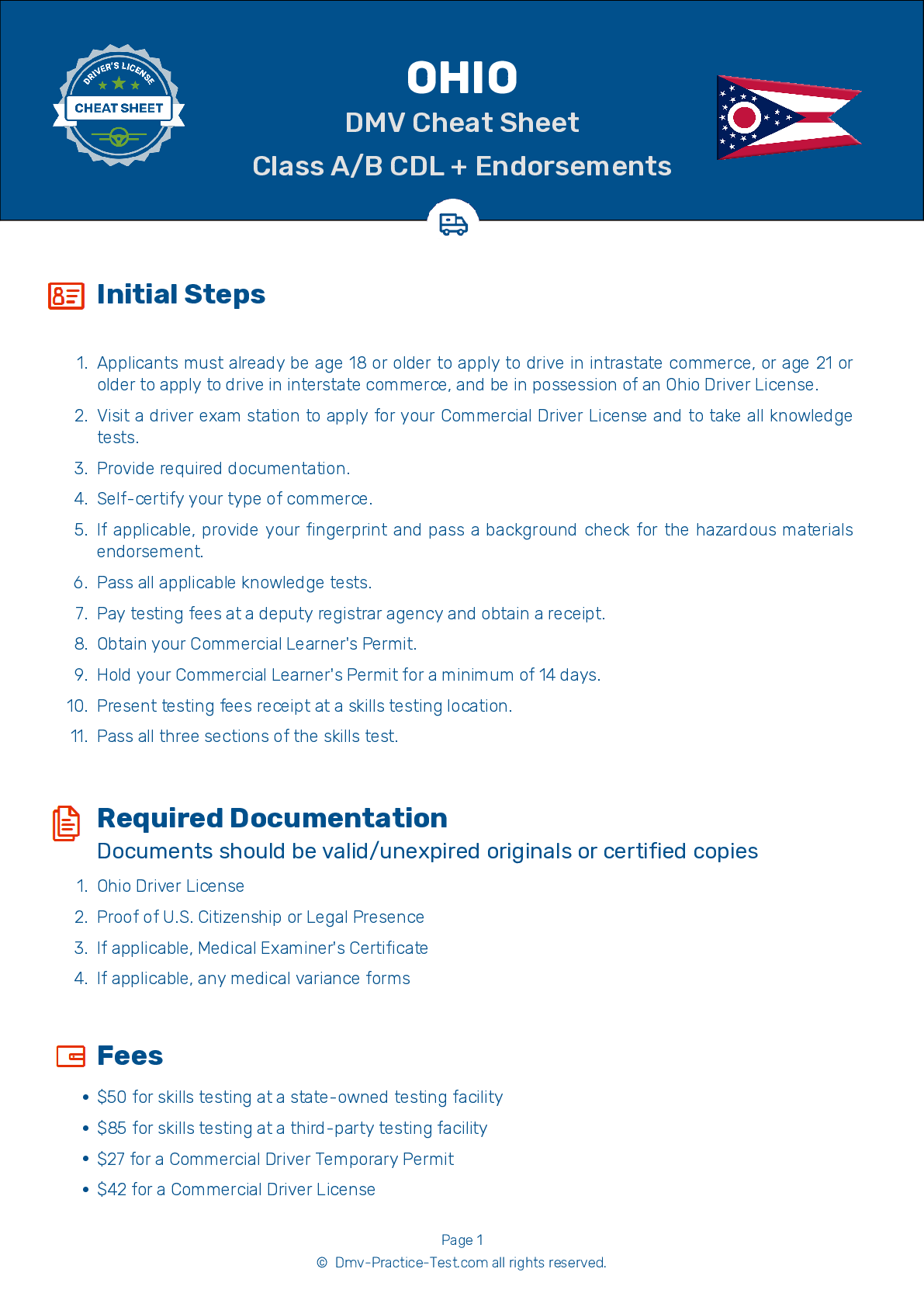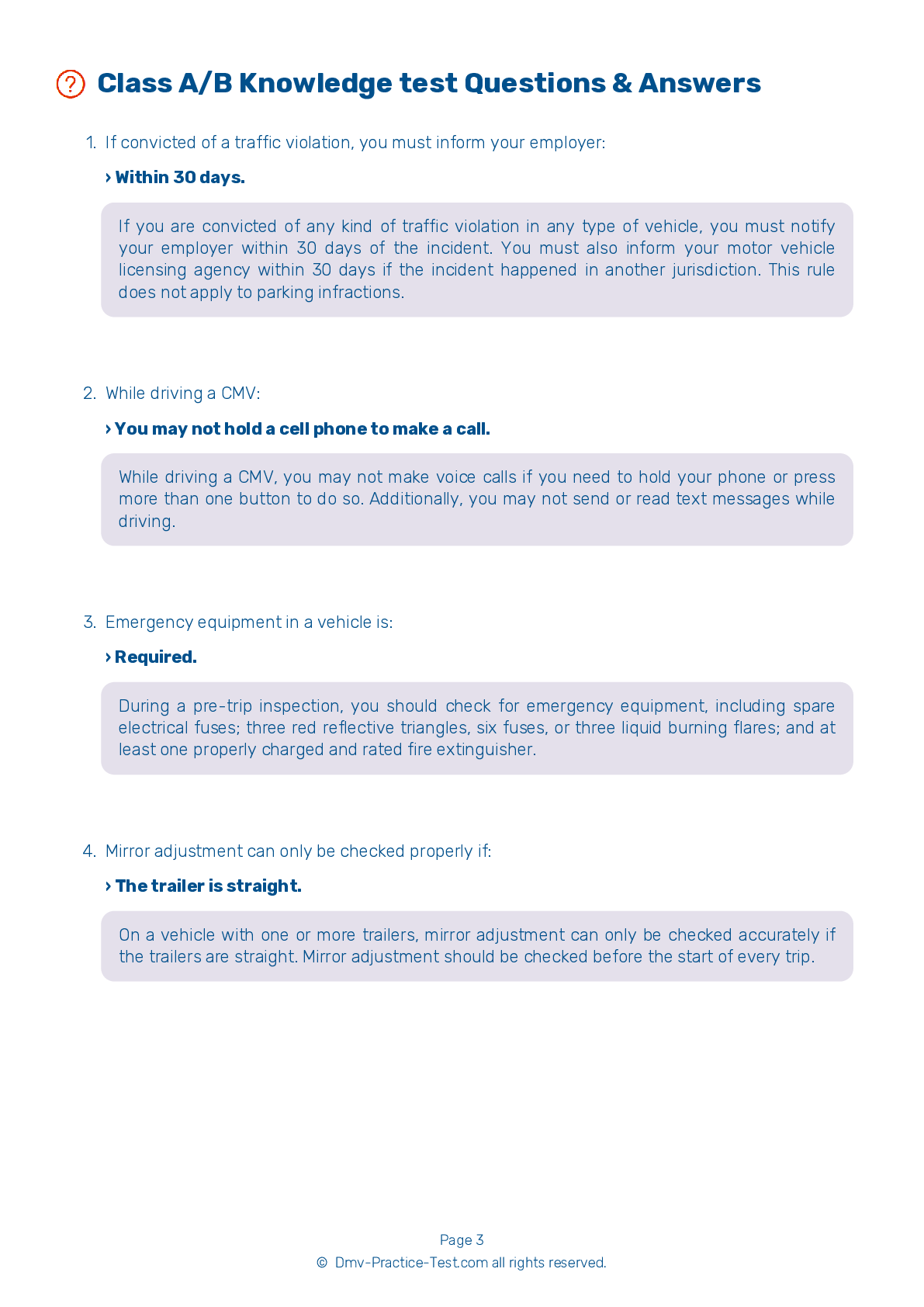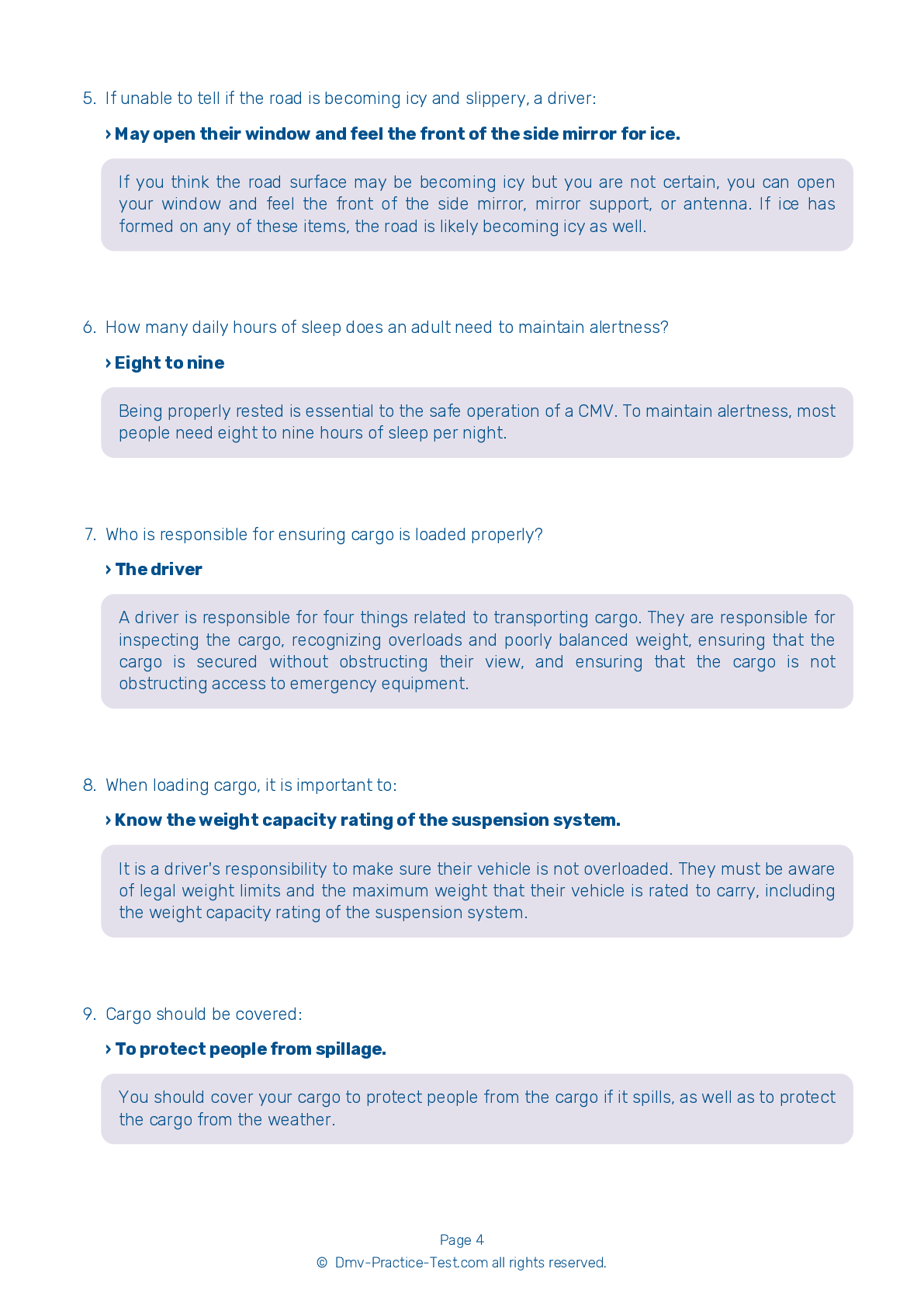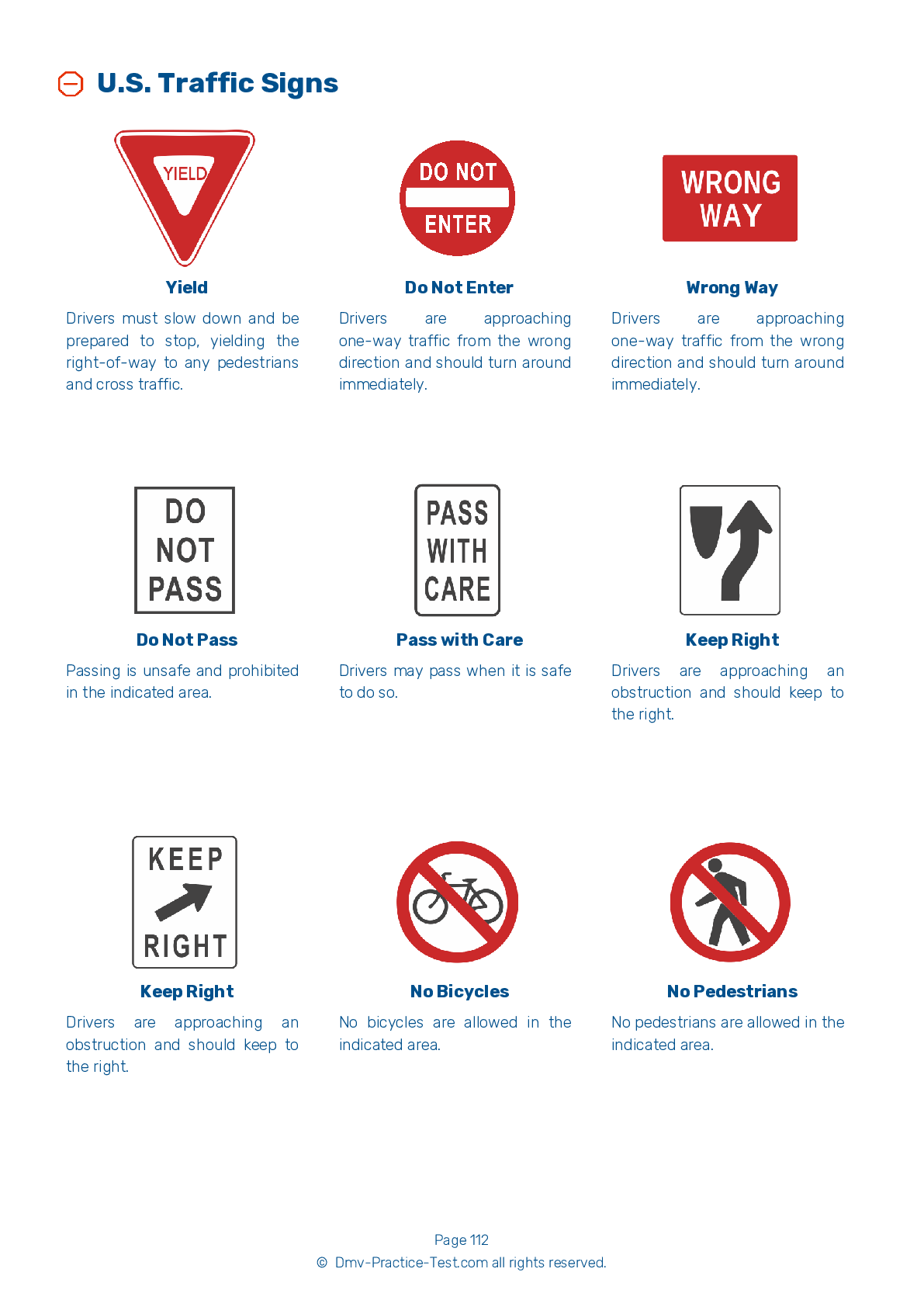Knowledge Test Class B #1
Class B Driving Test | Ohio 2025 #1
Train for FREE online with our Ohio class B license test. The official exam test consists of several obligatory parts, with all of them checking your knowledge of different blocks of road rules. If you need to obtain a OH CDL class B permit in 2025, practice as much as possible. Free sample tests published on our website will help you check and improve your knowledge and boost your grades. Please bear in mind that CDL class B requirements may vary from state to state.
50
40
20
1 . Which of the following is not a sign of fatigue?
Potential warning signs of fatigue include difficulty focusing, frequent blinking, or heavy eyelids; yawning repeatedly or rubbing your eyes; daydreaming; wandering or disconnected thoughts; trouble remembering the last few miles you've driven; missing exits or traffic signs; having trouble keeping your head up; drifting from your lane; following too closely; hitting a shoulder rumble strip; or feeling restless and irritable.
2 . When exiting a vehicle, a driver should:
When exiting your vehicle during the basic vehicle control skills test, you must face the vehicle and maintain three points of contact at all times. If your testing vehicle is a bus, you must maintain contact with the handrail. Exiting the vehicle incorrectly may result in automatic failure of the basic vehicle control skills test.
3 . Always perform the steps of a pre-trip inspection in the same order each time because:
Completing the steps of a vehicle inspection in the same order before every trip aids in learning what the proper steps are. Additionally, you be less likely to forget a step when going through the checklist in a prescribed order.
4 . The air compressor is connected to the:
The air compressor of an air brake system is connected to the engine through gears or a v-belt. The compressor may be air-cooled or cooled by the engine cooling system.
5 . Your horn should be used to:
Your vehicle's horn is a tool to warn others of your presence. Because the horn may create danger by startling other drivers, you should use it only if necessary.
6 . When turning, when should the turn signal be canceled?
Always signal continuously through a turn. Do not cancel a signal until the turn is finished.
7 . If you are braking on dry pavement while traveling at 55 mph, how much distance will brake lag add to your overall stopping distance?
The total stopping distance for vehicles equipped with air brakes is made up of four factors: perception distance, reaction distance, brake lag distance, and braking distance. When braking at a speed of 55 mph while driving on dry pavement, the brake lag can add around 32 feet to the vehicle's total stopping distance.
2025 Ohio | Frequently Asked Questions
To acquire a CDL Tank endorsement in Ohio, you need to have a valid Ohio CDL. You must pass the Tank Vehicle section of the Ohio CDL permit test. The test covers knowledge on inspecting tank vehicles, driving tank vehicles, and safe driving rules. Study materials can be found in the Ohio CDL Handbook.
To obtain a CDL Tank license in Ohio, you must already possess a valid Commercial Driver's License (CDL). Then you'll need to pass the Tank Vehicle endorsement test, which covers the special driving procedures and precautions related to operating a tank vehicle. Finally, you may also need to pass a skills test in a tank vehicle, depending on your state's requirements.
While Ohio does not mandate specific training or experience to obtain a CDL Tank endorsement, it's highly recommended. You must pass the Tank Vehicle endorsement test, which requires understanding the unique operations of tank vehicles. Many applicants find training courses or experience driving these vehicles beneficial in successfully passing the test.
Yes, in Ohio, to obtain a CDL Tank endorsement, you must pass the Tank Vehicle endorsement test. This written test focuses on the operation and safety considerations specific to tank vehicles. The topics include inspecting tank vehicles, driving tank vehicles, and safe driving rules related to these types of vehicles.
The written test for the CDL Tank endorsement in Ohio covers topics such as inspecting tank vehicles, driving tank vehicles, safe driving rules, handling emergencies, and understanding the different types of tanks. It also includes questions about the special requirements for loading and unloading tank vehicles.
The CDL Tank endorsement assessment doesn't involve practical driving skills or maneuvers. Instead, it's a written test focusing on theoretical knowledge. Subjects include understanding high center of gravity, surge, inspecting tank vehicles, special driving rules and procedures, and handling emergencies specific to tank vehicles.
Drivers with a CDL Tank endorsement must adhere to all federal and state regulations for commercial drivers, including hours of service limitations. They must also follow specific rules for transporting liquids, such as weight restrictions and handling procedures. Additionally, if a driver's tank vehicle carries hazardous materials, they need a HazMat endorsement in addition to the Tank endorsement.
No, it's illegal to transport liquid or gaseous materials in a tank vehicle without a valid CDL Tank endorsement. This rule applies to commercial vehicles that have a tank with a capacity of 1,000 gallons or more. Violating this rule can result in fines, CDL disqualification, or even criminal charges depending on the severity of the violation.
The CDL Tank endorsement can be added to your existing CDL. You don't need to apply for a new license. However, you'll need to pass the Tank Vehicle written test. Once you pass, the endorsement will be added to your CDL, and you can legally operate tank vehicles. Please check with your local DMV for specific procedures and fees.
Yes, handling hazardous materials requires not only a CDL Tank endorsement but also a HazMat endorsement. This entails passing a written test and a federal background check. It's essential to understand specific regulations for transporting hazardous materials including proper loading, unloading, and emergency handling procedures to ensure safety on the road.



